Blog by Paresh Deshpande
Last year while on a Face Time chat with my Guru, Mentor and friend, Steve Laug, we got talking about the Bertram lot that he had been working on at that point in time. He spoke about how overwhelming it was just to look at the large lot of about 200 plus pipes that he and Jeff had acquired. Never to miss an opportunity to add to my meager pipe lot that was available for me to work on, I suggested that if it was okay with him I would be more than willing to take a few of them off his hands. We worked out the details and soon a job lot of 12 pipes traveled all the way from US to Canada and then on to India!!! That was one long journey undertaken by this lot of Bertram pipes. Here is the lot of Bertram pipes that I received. This lot contained a variety of nicely shaped and grained pipes which I had been looking forward to work on. Here is the picture of the Bertram lot as it came to me. The first pipe that I decided to work on from this lot is a classic Lovat, marked in yellow arrow, with beautiful loosely packed bird’s eyes to the sides of the stummel and cross grains to the front, back and over the shank surfaces. This pipe is stamped on the left shank surface as “Bertram” in running hand over “WASHINGTON D.C” in block capital letters, font size reducing from left to right. The grade code “25” is stamped below the letter W. The stampings are all crisp and deep. The short vulcanite saddle stem is sans any stampings. The size and feel of the pipe is solid in hand.
The first pipe that I decided to work on from this lot is a classic Lovat, marked in yellow arrow, with beautiful loosely packed bird’s eyes to the sides of the stummel and cross grains to the front, back and over the shank surfaces. This pipe is stamped on the left shank surface as “Bertram” in running hand over “WASHINGTON D.C” in block capital letters, font size reducing from left to right. The grade code “25” is stamped below the letter W. The stampings are all crisp and deep. The short vulcanite saddle stem is sans any stampings. The size and feel of the pipe is solid in hand.  This pipe has been well researched and chronicled by Steve when he worked on many of the Bertram pipes in his possession and thus, shall not waste time in proverbial “reinventing the wheel”. Interested readers may like to follow the link given below to get to know the brand better (https://rebornpipes.com/2019/04/10/the-4th-of-a-collection-of-bertrams-a-bertram-dublin-70s/).
This pipe has been well researched and chronicled by Steve when he worked on many of the Bertram pipes in his possession and thus, shall not waste time in proverbial “reinventing the wheel”. Interested readers may like to follow the link given below to get to know the brand better (https://rebornpipes.com/2019/04/10/the-4th-of-a-collection-of-bertrams-a-bertram-dublin-70s/).
Initial Visual Inspection
This pipe has a decent medium bowl size with a longish round shank and short saddle stem rendering it a classic Lovat shape. The stummel boasts of some beautiful cross grains to the front and back of the bowl and all around the shank. The stummel is covered in dirt and grime of the overflowed lava. The entire stummel is peppered with a number of fills, both large and small. There is a thick layer of cake in the chamber and some damage is likely to the back of the rim top surface. The stem is lightly oxidized with no bite marks to the button edge or tooth chatter in the bite zone. The pipe appears as it sits on my work table presents an encouraging picture.

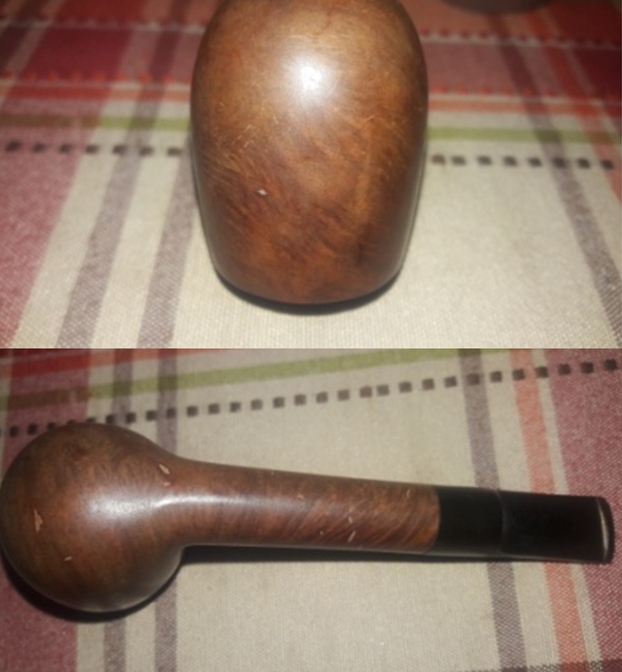 Detailed Inspection Of The Pipe And Observations
Detailed Inspection Of The Pipe And Observations
The bowl appears round with a wide rim and a depth of about 2 ¼ inches. The draught hole is in the center and at the bottom of the chamber. The chamber has an even layer of thick hard cake with remnants of un-burnt tobacco seen at the heel of the chamber. A fill (?) can be seen to the left in the 8 o’clock direction (indicated with a yellow arrow) over the smooth rim top surface. The rim surface is covered with lava overflow and has max accumulation in the 6 o’clock direction. Through this layer of lava, a few dings can be seen over the rim top surface. The inner rim edge in the 6 o’clock direction appears dark and worn out. The outer rim edge is sans any damage. The condition of the inner walls of the chamber can be commented upon after the cake has been taken down to the bare briar. There is a sweet smell in the chamber which is not very strong. The suspected fill over the rim top surface appears just that…. A fill! However, once the lava overflow from the rim top is removed that can I say, with any certainty, if it is a crack or otherwise. The stummel appears solid to the touch all around and hence I do not foresee any serious damage to the walls in the form of burnout/ deep heat fissures/ lines or pits. The dark inner rim edge, in the 6 o’clock direction, may be charred further than anticipated and the same will be confirmed after the surface has been thoroughly cleaned. I need to resort to topping the rim top in order to address the damage to the surface. The ghost smells should reduce once the cake from the chamber is removed and the shank has been cleaned.
 The smooth stummel surface is covered in dust and grime through which one can make out the beautiful cross grains to the front and back of the bowl and shank. The stummel surface is peppered with numerous small fills. These fills stand out like flesh wounds against the briar surface. The briar is looking lifeless and bone dry. Once the stummel has been thoroughly cleaned, these fills will be more apparent. I intend to refresh only those fills which have loosened out with a fresh fill of briar dust and superglue. Thorough cleaning and rising of the stummel under warm water should loosen old fills while also serving to highlight the grain patterns. Micromesh polishing will help in blending these fills while imparting a nice shine to the briar.
The smooth stummel surface is covered in dust and grime through which one can make out the beautiful cross grains to the front and back of the bowl and shank. The stummel surface is peppered with numerous small fills. These fills stand out like flesh wounds against the briar surface. The briar is looking lifeless and bone dry. Once the stummel has been thoroughly cleaned, these fills will be more apparent. I intend to refresh only those fills which have loosened out with a fresh fill of briar dust and superglue. Thorough cleaning and rising of the stummel under warm water should loosen old fills while also serving to highlight the grain patterns. Micromesh polishing will help in blending these fills while imparting a nice shine to the briar. 

 The mortise shows accumulation of oils, tars and gunk and the air flow is not full and smooth. The shank end rim surface has a chipped edge which is encircled in red. Along with the rim top fill/ chipped surface, I shall fill this gouge with briar dust and superglue mix.
The mortise shows accumulation of oils, tars and gunk and the air flow is not full and smooth. The shank end rim surface has a chipped edge which is encircled in red. Along with the rim top fill/ chipped surface, I shall fill this gouge with briar dust and superglue mix.  The high quality vulcanite saddle stem is lightly oxidized. Some minor tooth chatter and calcified deposit is seen on both the upper and lower stem surfaces in the bite zone and at the bottom of the button edge respectively. The tenon has accumulated ash and oils/ tars that have dried out on the inside as well as on the outside. The horizontal slot has scratch marks which will have to be addressed. The tooth chatter and the calcified deposits will be removed by sanding with a piece of 220 grit sand paper.
The high quality vulcanite saddle stem is lightly oxidized. Some minor tooth chatter and calcified deposit is seen on both the upper and lower stem surfaces in the bite zone and at the bottom of the button edge respectively. The tenon has accumulated ash and oils/ tars that have dried out on the inside as well as on the outside. The horizontal slot has scratch marks which will have to be addressed. The tooth chatter and the calcified deposits will be removed by sanding with a piece of 220 grit sand paper.  The Process
The Process
I started the restoration of this pipe by first cleaning the internals of the stem with bristled pipe cleaners and 99.9% pure isopropyl alcohol. I scraped out the dried oils and tars from the tenon end with my fabricated knife and also removed the dried oils and tars from the slot end. I followed it up by sanding the entire stem with a folded piece of 220 grit sand paper to remove the surface oxidation. It has been our (Abha, my wife and self) experience that sanding a stem before dunking it in to the deoxidizer solution helps in bringing the deep seated oxidation to the surface which in turn make further cleaning a breeze with fantastic result.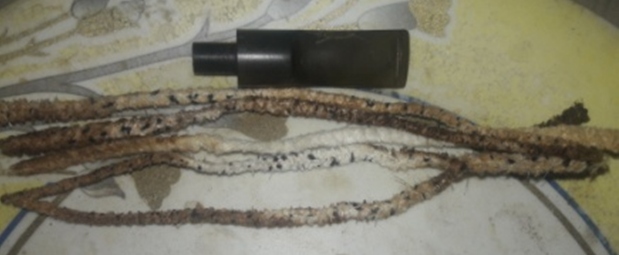 I dropped the stem in to “Before and After Deoxidizer” solution developed by my friend Mark Hoover. The solution helps to draw out heavy oxidation to the surface, making its further removal a breeze, while the minor oxidation is eliminated to a very great extent. The initial sanding helps to draw out the complete oxidation as the sanding opens up the stem surface that has been initially covered with oxidation. I usually dunk stems of 4-5 pipes that are in-line for restoration and this pipe is marked in green arrow. I generally allow the stems to soak in this solution overnight to do its work.
I dropped the stem in to “Before and After Deoxidizer” solution developed by my friend Mark Hoover. The solution helps to draw out heavy oxidation to the surface, making its further removal a breeze, while the minor oxidation is eliminated to a very great extent. The initial sanding helps to draw out the complete oxidation as the sanding opens up the stem surface that has been initially covered with oxidation. I usually dunk stems of 4-5 pipes that are in-line for restoration and this pipe is marked in green arrow. I generally allow the stems to soak in this solution overnight to do its work.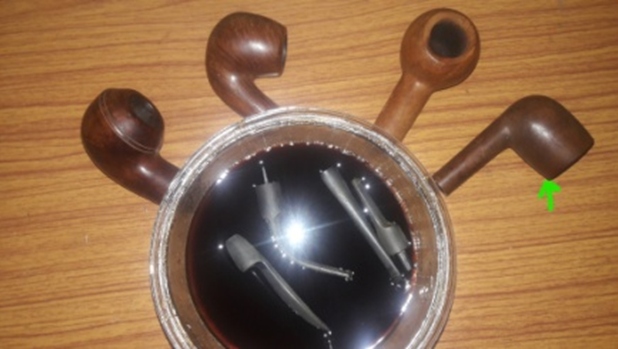 While the stem was soaking in the deoxidizer solution, I worked on the stummel by first reaming the chamber with size 2 followed by size 3 Castleford reamer head. I further scraped the chamber walls with my fabricated knife to remove the remaining carbon deposits where the reamer head could not reach. I scraped out the lava overflow from the rim top surface, especially from the area in the 6 ‘O’ clock direction. Once the cake was reamed back to the bare briar, I used a 150 grit sand paper followed by 220 grit sand paper to remove all the traces of remaining cake and also to smooth out the inner walls of the chamber surface. Finally, to remove the residual carbon dust, I wiped the chamber with a cotton pad wetted with 99.9% pure isopropyl alcohol. The chamber walls are pristine without any damage. Thankfully the inner rim was not charred under the lava overflow. The ghost smells are negligible and should further reduce after the shank/ mortise are thoroughly cleaned. The scraping of lava from the rim top has confirmed that the damage on the left side is indeed a fill and it would need to be refreshed.
While the stem was soaking in the deoxidizer solution, I worked on the stummel by first reaming the chamber with size 2 followed by size 3 Castleford reamer head. I further scraped the chamber walls with my fabricated knife to remove the remaining carbon deposits where the reamer head could not reach. I scraped out the lava overflow from the rim top surface, especially from the area in the 6 ‘O’ clock direction. Once the cake was reamed back to the bare briar, I used a 150 grit sand paper followed by 220 grit sand paper to remove all the traces of remaining cake and also to smooth out the inner walls of the chamber surface. Finally, to remove the residual carbon dust, I wiped the chamber with a cotton pad wetted with 99.9% pure isopropyl alcohol. The chamber walls are pristine without any damage. Thankfully the inner rim was not charred under the lava overflow. The ghost smells are negligible and should further reduce after the shank/ mortise are thoroughly cleaned. The scraping of lava from the rim top has confirmed that the damage on the left side is indeed a fill and it would need to be refreshed.
 I followed up the reaming with cleaning the mortise using cue tips, pipe cleaners and shank brush dipped in isopropyl alcohol. I scraped the walls of the mortise with my fabricated knife to remove the dried oils and tars. The ghost smells are history and the chamber now smells clean.
I followed up the reaming with cleaning the mortise using cue tips, pipe cleaners and shank brush dipped in isopropyl alcohol. I scraped the walls of the mortise with my fabricated knife to remove the dried oils and tars. The ghost smells are history and the chamber now smells clean.  With the bowl internals clean, I move to clean the exterior of the stummel. I used a hard bristled tooth brush and Briar Cleaner, a product that has been developed by Mark Hoover, to scrub the stummel and rim top. I set the stummel aside for 10 minutes for the product to draw out all the grime from the briar surface. After 10 minutes, I washed the stummel under running warm water with anti oil dish washing detergent till the stummel surface was clean and dried it using paper towels and soft cotton cloth. I simultaneously cleaned the shank internals with the detergent and hard bristled shank brush and set the stummel aside to dry out naturally. The stummel surface has cleaned up nicely and the beautiful grain patterns are now on full display. The fills, even the smallest ones, are now clearly discernible. I probed each fill with a sharp dental tool to check for solidity and thankfully, each fill was nice and solid without any give.
With the bowl internals clean, I move to clean the exterior of the stummel. I used a hard bristled tooth brush and Briar Cleaner, a product that has been developed by Mark Hoover, to scrub the stummel and rim top. I set the stummel aside for 10 minutes for the product to draw out all the grime from the briar surface. After 10 minutes, I washed the stummel under running warm water with anti oil dish washing detergent till the stummel surface was clean and dried it using paper towels and soft cotton cloth. I simultaneously cleaned the shank internals with the detergent and hard bristled shank brush and set the stummel aside to dry out naturally. The stummel surface has cleaned up nicely and the beautiful grain patterns are now on full display. The fills, even the smallest ones, are now clearly discernible. I probed each fill with a sharp dental tool to check for solidity and thankfully, each fill was nice and solid without any give. 
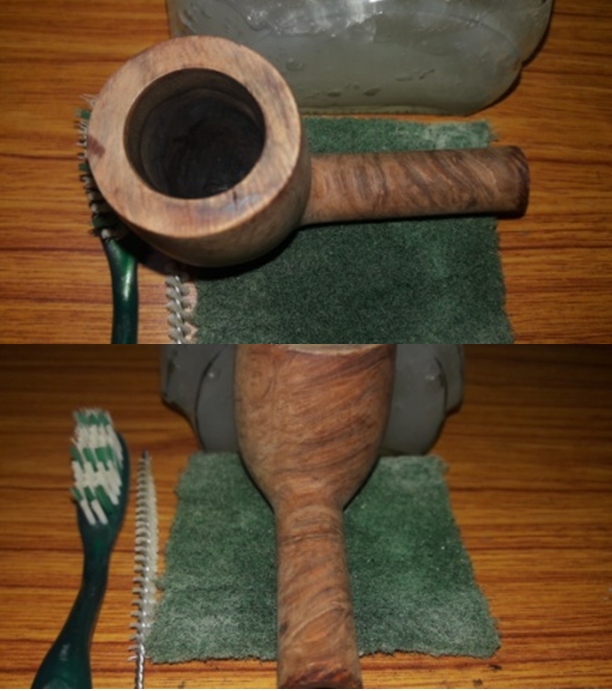
 While the stummel was drying, the next morning, Abha removed the stem that had been soaking in the deoxidizer solution overnight. She cleaned the stem under running warm water and scrubbed the raised oxidation from the stem surface using a scotch brite pad and cleaned the airway with a thin shank brush. She further removed the oxidation by scrubbing the stem with 0000 grade steel wool and applied a little EVO to rehydrate the stem. I need to further sand the stem to completely remove the oxidation.
While the stummel was drying, the next morning, Abha removed the stem that had been soaking in the deoxidizer solution overnight. She cleaned the stem under running warm water and scrubbed the raised oxidation from the stem surface using a scotch brite pad and cleaned the airway with a thin shank brush. She further removed the oxidation by scrubbing the stem with 0000 grade steel wool and applied a little EVO to rehydrate the stem. I need to further sand the stem to completely remove the oxidation.  My significant half, Abha, used a 220 grit sand paper to sand the stem and remove all the oxidation that was raised to the surface. This step further reduced the tooth chatter and bite marks present on the stem. She wiped the stem with Murphy’s Oil soap on a cotton swab. This helps in cleaning the stem surface while removing the loosened oxidation. As is the norm, whenever she works on a pipe, taking pictures NEVER EVER crosses her otherwise sharp mind!! No exceptions here…
My significant half, Abha, used a 220 grit sand paper to sand the stem and remove all the oxidation that was raised to the surface. This step further reduced the tooth chatter and bite marks present on the stem. She wiped the stem with Murphy’s Oil soap on a cotton swab. This helps in cleaning the stem surface while removing the loosened oxidation. As is the norm, whenever she works on a pipe, taking pictures NEVER EVER crosses her otherwise sharp mind!! No exceptions here…
While Abha was working on the stem, I worked on the stummel. It was time to address the fill over the rim top and the gouge over the shank end surface. I filled both these gouges with a mix of briar dust and superglue. I always use the layering method for such repairs (layer of glue is first applied over the target area and briar dust is pressed over the layer of glue). I repeated the process till the desired coverage and thickness was achieved. I set the stummel aside for the fills to cure. I shall have to be extremely careful while sanding the shank end surface as any uneveness will cause an uneven seating of the stem in to the mortise. Once the fills had cured, I topped the rim top over a piece of 220 grit sand paper till I had a smooth and even surface. With a folded piece of worn out 180 grit sand paper pinched between my thumb and forefinger, I carefully sand the shank end fill. With the same grit sand paper, I cleaned the bevel to the inner edge of the shank end of all the dripped mix of briar dust and glue. The reason I did not top the shank end was that any loss of briar from the shank end would result in shortening of the shank and a gap would be seen between the stem and shank end. The rim top surface and the edges look very neat at this stage.
Once the fills had cured, I topped the rim top over a piece of 220 grit sand paper till I had a smooth and even surface. With a folded piece of worn out 180 grit sand paper pinched between my thumb and forefinger, I carefully sand the shank end fill. With the same grit sand paper, I cleaned the bevel to the inner edge of the shank end of all the dripped mix of briar dust and glue. The reason I did not top the shank end was that any loss of briar from the shank end would result in shortening of the shank and a gap would be seen between the stem and shank end. The rim top surface and the edges look very neat at this stage. 
 I followed it by wet sanding the stummel with 1500 to 2000 wet & dry sand paper and further with 3200 to 12000 grit micromesh pads, wiping frequently with a moist cloth to check the progress. I really like the looks of the stummel at this point in restoration. The grains and the clean lines of this piece of briar are worthy of appreciation.
I followed it by wet sanding the stummel with 1500 to 2000 wet & dry sand paper and further with 3200 to 12000 grit micromesh pads, wiping frequently with a moist cloth to check the progress. I really like the looks of the stummel at this point in restoration. The grains and the clean lines of this piece of briar are worthy of appreciation. 

 Next, I rubbed a small quantity of “Before and After Restoration Balm” deep in to the briar with my finger tips and let it rest for a few minutes. The balm almost immediately works its magic and the briar now has a nice vibrant appearance with the beautiful grain patterns displayed in their complete splendor. I further buffed it with a horse hair brush. The dark browns of the bird’s eye and cross grains spread across the stummel makes for a visual treat. It really is a nice piece of briar.
Next, I rubbed a small quantity of “Before and After Restoration Balm” deep in to the briar with my finger tips and let it rest for a few minutes. The balm almost immediately works its magic and the briar now has a nice vibrant appearance with the beautiful grain patterns displayed in their complete splendor. I further buffed it with a horse hair brush. The dark browns of the bird’s eye and cross grains spread across the stummel makes for a visual treat. It really is a nice piece of briar. 

 With the stummel rejuvenation almost complete, save for the final wax polish, I worked the stem. To bring a deep shine to the vulcanite stem, I polished the stem, wet sanding with 1500 to 2000 grit sandpapers followed by further wet sanding with 3200 to 12000 grit pads. I wiped the stem with moist cloth after each pad and rubbed it down with Extra Virgin Olive oil to rejuvenate the vulcanite. The finished stem is shown below.
With the stummel rejuvenation almost complete, save for the final wax polish, I worked the stem. To bring a deep shine to the vulcanite stem, I polished the stem, wet sanding with 1500 to 2000 grit sandpapers followed by further wet sanding with 3200 to 12000 grit pads. I wiped the stem with moist cloth after each pad and rubbed it down with Extra Virgin Olive oil to rejuvenate the vulcanite. The finished stem is shown below.  I mount a cotton cloth buffing wheel on to my hand held rotary tool and polished the stummel and stem with Blue Diamond compound. This compound helps to remove the minor scratch marks that remain from the sanding. I mount another cotton buffing wheel that I have earmarked for carnauba wax and applied several coats of the wax. I finished the restoration by giving the entire pipe a rigorous hand buffing using a microfiber cloth to raise the shine further. The finished pipe looks amazingly beautiful and coupled with the size, heft and the hand feel, makes it quite a desirable pipe. If you feel that this pipe calls out your name, please let Steve know and we shall make arrangements for it to reach you.
I mount a cotton cloth buffing wheel on to my hand held rotary tool and polished the stummel and stem with Blue Diamond compound. This compound helps to remove the minor scratch marks that remain from the sanding. I mount another cotton buffing wheel that I have earmarked for carnauba wax and applied several coats of the wax. I finished the restoration by giving the entire pipe a rigorous hand buffing using a microfiber cloth to raise the shine further. The finished pipe looks amazingly beautiful and coupled with the size, heft and the hand feel, makes it quite a desirable pipe. If you feel that this pipe calls out your name, please let Steve know and we shall make arrangements for it to reach you.



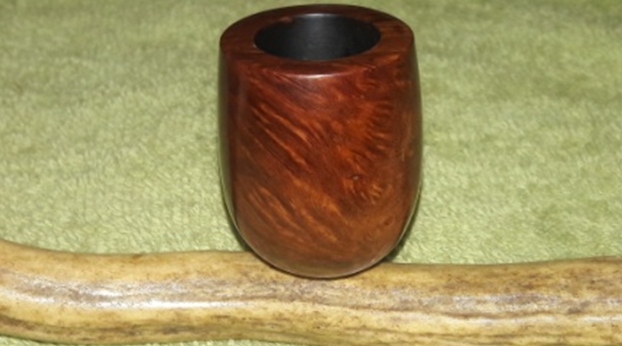


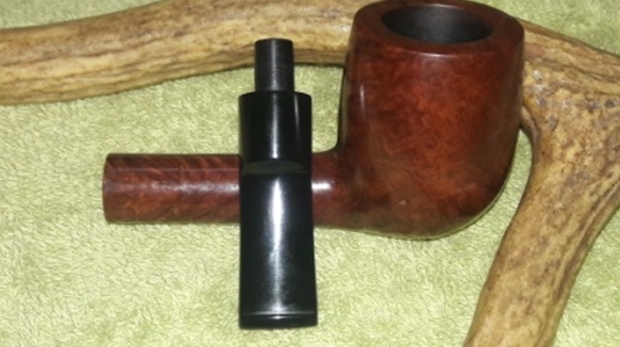 P.S. In one of my previous write up, a question “Why do I enjoy bringing these old battered and discarded pipes back to life?” had popped up in my mind. I had given one reason in my last write up and in all my subsequent write ups I intend to share with the readers my reasons as to why I really love this hobby.
P.S. In one of my previous write up, a question “Why do I enjoy bringing these old battered and discarded pipes back to life?” had popped up in my mind. I had given one reason in my last write up and in all my subsequent write ups I intend to share with the readers my reasons as to why I really love this hobby.
The second reason is that this pipe that is now discarded by the piper as being SPENT and has fallen out of favor, actually still has (mostly do!) potential to provide many more years of smoking pleasures to any piper. Just because it has fouled up or does not smoke as good as when it was new or has been damaged, does not mean that the piece of briar is at fault. It is just that it was not well looked after by the piper and it is he and he alone who is responsible. It provides me with immense pleasure and joy to work on such out of favor and discarded pipes and bringing them back to their real beauty and full functional potential for years ahead. I consider it my honor to work on such pipes that find their way on to my work table.
I wish to thank each one for sparing their valuable time to read through this write up and each one is my prayers. Stay home…stay safe!!

